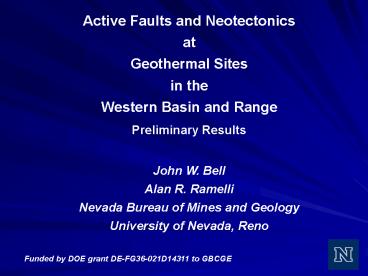Active Faults and Neotectonics PowerPoint PPT Presentation
1 / 29
Title: Active Faults and Neotectonics
1
Active Faults and Neotectonics at Geothermal
Sites in the Western Basin and Range Preliminary
Results John W. Bell Alan R. Ramelli Nevada
Bureau of Mines and Geology University of Nevada,
Reno Funded by DOE grant DE-FG36-021D14311 to
GBCGE
2
- Overview of Quaternary fault distribution in
western BR - High-temperature (gt100o C) geothermal sites
- Proposed model Young (Holocene) fault movement
is a criterion for potential high-temperature
resources - Methodology for detecting fault occurrence and
age - Examples of new fault data found at selected
high- temperature sites - Conclusions
- Most high-temperature sites are spatially and
structurally associated with seismically active
Holocene faults-- providing a potential
exploration tool
3
- W-NW-oriented crustal extension facilitates
dilation on N-NE-striking faults (Faulds et al.,
2005). - GPS data indicate extensional strain on
NE-striking faults (Blewitt et al., 2003). - Other structural models have included stress
redistribution along fault ruptures (Caskey and
Wesnousky, 2000 Wesnousky and Temple, 2004)
- Regional tectonic models account for some, but
not all, high- temperature geothermal
occurrences. - Not all favorably oriented faults are
high-temperature geothermal sites. - In this study, we propose a simple model in
which age of faulting (recent crustal strain
release) is a criterion for geothermal potential.
4
- Faults provide conduits for thermal
water - Recent fault ruptures provide best potential for
new or re-opened apertures - Surface-rupturing earthquakes (gtM 6.5-7.6) open
pathways along fault planes from crustal depths
to ground surface - Conceptual model
- Recent (Holocene) crustal strain release along
faults may facilitate geothermal potential
5
- Methodology
- Identify, determine the spatial association, and
age of most recent faulting at 37
high-temperature (gt100o C) sites (Coolbaugh et
al., 2003) - Employ low-sun-angle aerial photography to
detect unmapped Holocene (seismically active)
faults - Establish maximum age of faulting with
Quaternary stratigraphic relationships - Conduct exploratory trenching and age dating
6
USGS Quaternary fault and fold database of the
US http//earthquake.usgs.gov/regional/qfaults
7
- Low-sun-angle aerial photography
- Large-scale (112,000) BW
- Early morning and late afternoon sun conditions
- Sun angle 10-25o
- Allows detection of small, subtle fault traces
not visible on conventional mapping photography
(Camels courtesy of D.B. Slemmons)
8
Steamboat geothermal area
Mt Rose Hwy
Low-sun-angle aerial photograph early morning
conditions Steamboat Hills
9
Central Nevada seismic belt
10
1954 Dixie Valley
Magnitude 6.8-7.6 earthquakes
1915 Pleasant Valley
11
Geothermal sites structurally associated with
zones of historical faulting
Leach
Dixie Valley
Dixie Comstock
Stillwater
Eightmile
12
Dixie Valley geothermal area
13
Stillwater seismic gap
12 ka shoreline scarp
fault scarp
2.5 ka sinter
Most recent event offsets 2.5 ka sinter deposits
(Lutz et al., 2003)
14
Eightmile Flat geothermal area
- New 1954 surface ruptures found on Eightmile
Flat fault - Pre-1954 fault event on Eightmile Flat fault
offsets Holocene-age lacustrine deposits
15
Identify prehistoric Holocene faults
- Stratigraphic datum provided by late Pleistocene
Lake Lahontan - High shoreline at 13 ka
- Multiple recessional shorelines
- Lake sediments provide datable material, e.g.,
radiocarbon and tephra
Pleistocene Lakes in the Great Basin
(Reheis, 1999)
16
Holocene faults and high temperature geothermal
sites
Fly Ranch
Gerlach
Trego
Empire
Kyle
Needle Rock
Geothermal data from Coolbaugh et al. (2003)
17
Kyle Hot Springs Holocene faults found to control
hot springs
18
Empire geothermal area
San Emidio fault at geothermal site found to be
Holocene age
19
New Holocene fault traces found in San Emidio
Desert south of Empire geothermal area Possible
structural connection to Pyramid Lake geothermal
area
trench
trench
20
New Holocene faults found at Gerlach geothermal
area
21
(No Transcript)
22
New Holocene faults found at Fly Ranch geothermal
area
Fly Ranch geothermal area to south
23
New Holocene faults found at Trego geothermal area
24
New faults and fault ages found near Needle
Rock/North Pyramid Lake geothermal area
trench
Needle Rock geothermal area to west
25
2-3 ka beach gravel
30 ka tephra
shear zone
Hydrothermally altered basalt
26
New Holocene faults found at northeast margin of
Pyramid Lake May be structurally connected to
faults in Empire/San Emidio Valley area
27
Holocene and historical faults associated with 31
of 37 high-temperature geothermal sites
High probability that unmapped faults will be
found at other sites
28
Not all Quaternary faults are sites of geothermal
activity including those in favorable
NNE-striking orientations
Spatial-temporal associations suggest that recent
seismic strain release is a factor in occurrence
of geothermal activity
29
- Preliminary Conclusions
- Most high temperature geothermal sites are
spatially and structurally associated with
seismically active Holocene faults - Out of a total of 37 high-temperature sites, at
least 31 sites are located in close proximity to
Holocene faults. Five sites are associated with
historical fault ruptures - Analysis of low-sun-angle aerial photography and
field investigation indicate that numerous
unmapped and undated Holocene faults are present
near geothermal sites - Results support the conceptual model that
geothermal potential may be related to recent
crustal strain release along faults - Results suggest that active fault identification
may be useful exploration tool in identifying and
segregating sites of potential geothermal
resources

